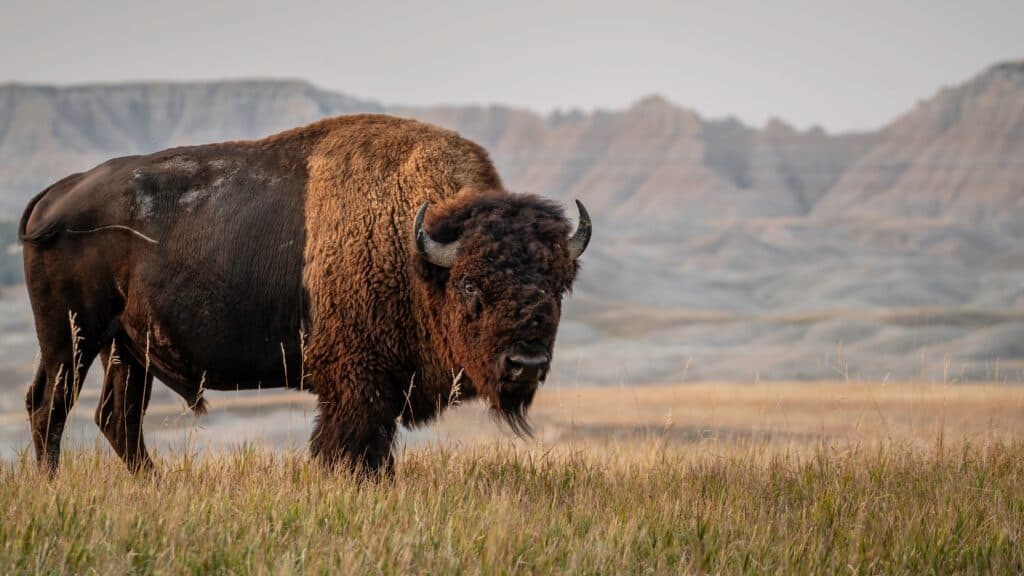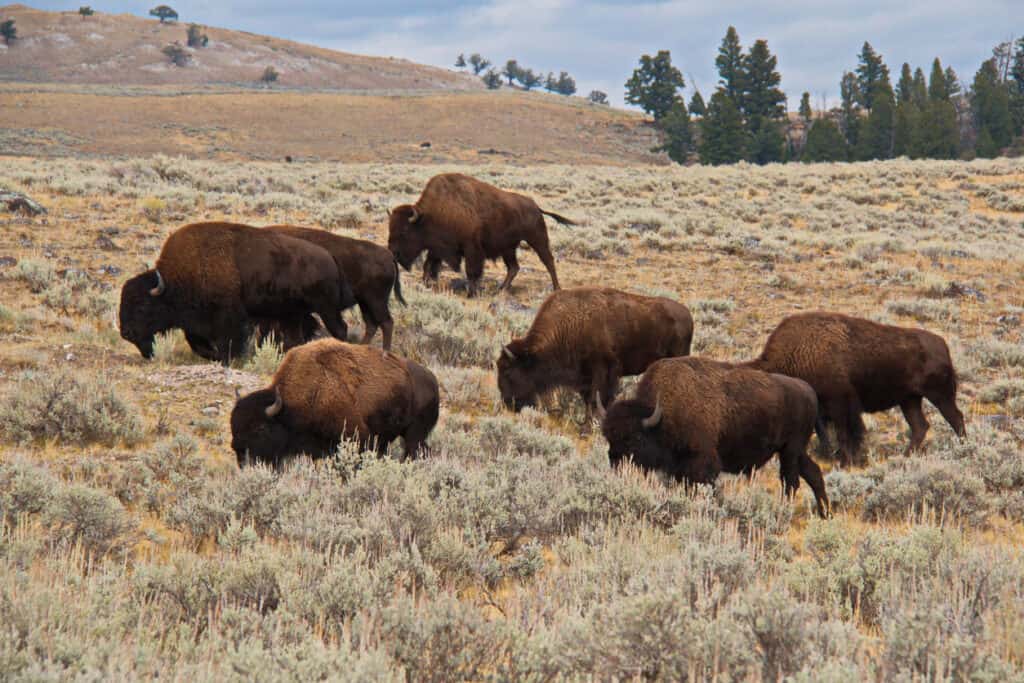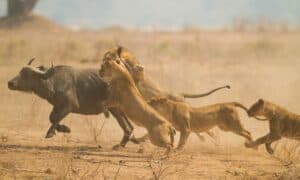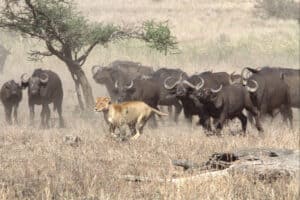There is no more iconic symbol of the American West than the Buffalo. The species Bison bison, commonly known as the American bison or buffalo, has two recognized subspecies. Bison bison bison, also known as the plains bison or the American plains bison historically roamed the grasslands of North America from Northern Mexico to Canada. Bison bison athabascae, also known as the wood bison or mountain bison once ranged across Western Canada to Alaska.
Prior to the arrival of European colonizers, Bison bison populations were estimated to be in the millions. However, by the late 19th century, they had been reduced to mere hundreds from overhunting, habitat loss, and disease. Their numbers are currently rebounding thanks to conservation efforts. Bison bison has several eye-catching features from their thick fur to their long, curved horns. Though they’re not as noticeable, buffalo teeth are also quite fascinating. So, what makes buffalo teeth enthralling? Keep reading to find out!

has several eye-catching features from their thick fur to their long horns.
©Tim Malek/Shutterstock.com
What Kind of Teeth Do Buffalo Have?
Buffalos like other ruminants have a unique dental structure that includes the absence of upper front teeth (incisors) in their dentation. Instead of upper incisors, buffalos have a tough, fibrous pad called the dental pad that is used for grabbing and pulling vegetation. The dental pad is located in the front of the upper jaw and is covered with a layer of keratin, the same protein that makes up hair, nails, hooves, and claws. The keratin layer is always worn down and regrown, keeping the dental pad in good condition for feeding. The absence of upper incisors is an adaptation that allows Bison bison to more efficiently graze on tough, fibrous vegetation. Because they do not have upper incisors, they are able to effectively wrap their tongue around the vegetation and pull it into their mouths, helping them to eat more quickly and efficiently.
Buffalo teeth are composed of enamel, dentin, and pulp. Enamel, the hardest tissue in the body, is composed of closely packed crystals of a mineral called hydroxyapatite, which gives enamel its hardness and also durability. The enamel covers and protects the dentin. Dentin is a hard, mineralized tissue that forms the bulk of the tooth structure, and encases the pulp. The pulp is the soft tissue inside the tooth that contains blood vessels and nerves.
Baby Buffalo Teeth
Buffalos have two sets of teeth in their lifetime: deciduous (baby or milk) teeth and permanent teeth. The deciduous teeth erupt during the first few weeks of life. Bison bison have a total of 20 deciduous teeth, which consist of 8 incisors (front teeth) and 12 premolars. These deciduous teeth are apportioned as follows:
- Upper jaw: No incisors; 3 premolars on each side
- Lower jaw: 8 incisors and 3 premolars on each side
The incisors are located at the front of the mouth and are used for grasping and tearing vegetation. The premolars are located behind the incisors and are used for grinding and chewing.
Ruminants
Buffalo calves, like other ruminants, are born with a dental pad in the place of upper incisors. It is present and functional from birth. The dental pad is a hard, flat surface made of keratin that is located in the front of the upper jaw. It is used to grind and crush vegetation in concert with the lower incisors. When the buffalo chews its food, it is first broken down into small pieces by the teeth. These small pieces are then mixed with saliva and swallowed, where they enter the rumen, before entering the reticulum, the first two compartments of their four-chambered stomach. In these compartments, the food is broken down by a process called fermentation, before being regurgitated back into the mouth for further chewing. This cycle is repeated several times until the food is sufficiently broken down and can be digested by the buffalo.

, like other ruminants, are born with a dental pad in the place of upper incisors.
©Marcia Straub/Shutterstock.com
As bison calves mature they start to develop their permanent teeth. The first permanent teeth to erupt are the lower incisors, which begin to appear between 1-2 years of age. The rest of the permanent teeth, including the molars and premolars, gradually come in over the next few years, typically in pairs. Most buffalo will have a full set of permanent teeth by the time they are five years old.

Buffalo teeth are adapted to their herbivorous diet, which consists of tough, fibrous vegetation.
©iStock.com/Karel Stipek
Adult Buffalo Teeth
Buffalo teeth are adapted to their herbivorous diet, which consists of tough, fibrous vegetation. Buffalos have eight lower incisors, 12 premolars, and 12 molars. Though they don’t have true canines, buffalos’ corner incisors are often referred to as canines. As previously mentioned, buffalos do not have upper incisors. Instead, they have a dental pad. The dental pad works with the lower incisors to grasp and tear vegetation. Buffalo premolars, (12 total; six upper, six lower), are the teeth located between the incisors and molars. Premolars are used for grinding and crushing food.
The tops of these teeth have a large surface area with ridges and cusps that help to break down tough plant fiber. The premolars work in combination with the bison’s strong jaw muscles to grind and crush the food. Buffalos also have a set of 12 (six upper, six lower) large teeth called molars in the very back of their mouth. The molars are used for grinding up vegetation. These molars have high crowns (or ridges) that help break down tough plant matter.
Teeth with high crowns are called hypsodont teeth. Hypsodont teeth are adapted for grinding and chewing fibrous plant matter. Buffalo teeth have several layers of enamel, which makes them more resistant to wear. However, the teeth of Bison bison do wear down over time due to their abrasive diet.
Buffalo teeth are not only fascinating adaptations of their herbivorous diet they are also valuable tools for understanding the ecology and history of this iconic North American species.
The photo featured at the top of this post is © iStock.com/Jillian Cooper
FAQs (Frequently Asked Questions)
What is the lifespan of a buffalo?
The average lifespan of a Bison bison, or American bison, in the wild is around 15 to 20 years. However, bison in captivity can live longer, with some individuals reaching 25 years or more.
Several factors can affect the lifespan of bison, including diet, predation, disease, and environmental conditions. In the wild, bison are susceptible to predation by wolves, bears, and mountain lions, which can shorten their lifespan.
How many buffalo are there in North America? Are they an endangered species?
The population of Bison bison was estimated to be around 30-60 million prior to the arrival of Europeans in North America. However, due to overhunting, habitat loss, and disease, their population was decimated to only a few hundred individuals by the late 1800s.
Conservation efforts were then initiated, and the population of Bison bison has since increased, but it is still significantly lower than it once was.According to the International Union for Conservation of Nature (IUCN), as of 2021, the total population of plains bison (Bison bison bison) is estimated to be around 31,000 individuals in North America. The population of wood bison (Bison bison athabascae) is estimated to be around 10,000 individuals in Canada and Alaska.
While the populations of both subspecies have increased from their historic lows, their numbers are still significantly lower than they were prior to European colonization. Therefore, the species Bison bison is classified as near threatened by the IUCN.
How fast can a buffalo run?
Although they aren’t exactly built for speed, and they would prefer to trot or amble, Bison bison can achieve speeds of 35-40 miles per hour (56-64 kmph) over short distances.
Can you tell how old a buffalo is from its teeth?
Yes! The condition of the teeth can be used to estimate the age of a bison. Like other ungulates, bison have a specific pattern of tooth eruption and wear that can be used to determine their age within a certain range.
In young bison, the milk teeth are present until they are about two years old, at which point they are replaced by permanent teeth. The age of a bison can be estimated by the presence or absence of milk teeth and the degree of wear on the permanent teeth.
For example, in a bison that is between two and four years old, the permanent incisors will start to show some wear, and the molars will have a distinct pattern of ridges and cusps.
As the bison ages, the teeth will continue to wear down, and the ridges and cusps on the molars will become smoother and less distinct. By examining the wear and condition of the teeth, it is possible to estimate the age of a bison within a few years, although this method of age estimation becomes less accurate in older animals, as the teeth can become more variable in their wear and condition.
Do people eat buffalo?
Yes! People do eat bison. Bison meat is lean and rich in protein, iron, and other nutrients. It is often used as a substitute for beef in recipes and is available in many grocery stores and restaurants in North America. Bison meat is considered a healthier alternative to beef because it is lower in fat. Additionally, bison ranching is considered a sustainable and environmentally-friendly practice, making bison meat an appealing choice for many consumers.
Thank you for reading! Have some feedback for us? Contact the AZ Animals editorial team.






